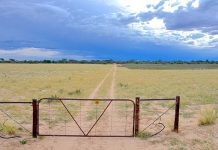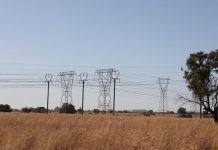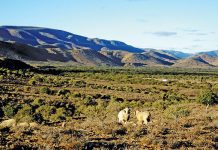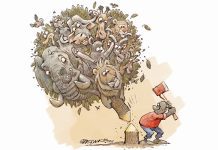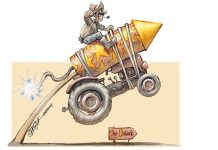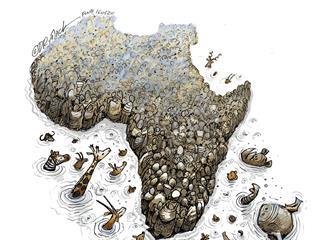
Africa’s human population is growing at a rapid pace, and the continent’s resources are finite. Enhancing and conserving Africa’s biodiversity is the only way to ensure its people’s continued survival.
READ:Predicting the future of farming
Global population growth is threatening human existence, but it is a subject that NGOs appear unwilling to take on. In its 2014 Living Planet Report, the World Wide Fund for Nature spoke of the threat of massive land degradation, but gave inadequate attention to the issue of population growth.
The 2015 UN Climate Change Conference in Paris did not raise population growth as a major concern. This is despite the enormous growth of cities, particularly in Africa, resulting in accelerating atmospheric pollution and with concerns being raised about where the food will be sourced to feed the people in these cities.
A 2014 paper by Prof Malcolm Potts of the University of California’s School of Public Health, titled ‘Getting family planning and population back on track’ stated that “virtually all biologists and climatologists, along with an increasing number of sensible economists, would agree that a world with 6,8 billion people in the year 2100 would be more likely to be biologically sustainable, healthier, more educated, and less violent than one with 16,6 billion”.
Africa’s human population has tripled in the last 40 years to 1,17 billion in 2015. In sub-Saharan Africa, 239 million people are undernourished, and 12 people die of hunger every minute. South Africa has approximately 14 million people – the highest figure by far in the Southern African Development Community – who are food-insecure.
A total of 74,4% of these people are in our country’s rural areas. These figures unequivocally demonstrate that agricultural development to enhance food security should be at the top of the agenda on the continent. Without food security, there is no chance of a sustainable future for people.
Engage with rural communities
About 40 years ago, several colleagues and I at the Institute of Natural Resources, which was founded in 1980 and based at what was then the University of Natal, began researching the sustainability of land use practices in Africa. In particular, I wanted to understand the impact of land degradation on our continent’s network of protected areas.
This required me to look at what was happening across the fence, and ask, “Will the protected areas network survive if we do not take a broad look at the goings-on in the areas surrounding this network?”
Understanding the needs of rural dwellers
One of the aspects that my colleagues and I began investigating was the massive deforestation of Africa’s indigenous forests. This was taking place as a result of people in areas surrounding the protected areas network collecting wood for cooking and housing.
My colleague, the late Mark Gandar, was one of the first to quantify the extent of this wood consumption and deforestation. He found that each person living in Africa’s subsistence economy who was dependent on wood harvested from our continent’s indigenous forests, utilised, on average, 750kg of wood per year. This was a huge impact and we wanted to know what was being done about it. Why were woodlots not being introduced in areas like these to prevent the destruction of Africa’s indigenous forests?
Another colleague, Sue Milton, conducted a study into the potential for harvesting the terminal branches of indigenous Acacia trees, and chopping these up as fodder for the livestock of subsistence farmers.
A third study determined the impacts of traditional fishing methods on the indigenous fish stocks in the pans of Maputaland. Were these methods sustainable options to enhance food security in the parts of rural Africa surrounding the protected areas network? And if not, why not? What alternatives existed?
Throughout our research, great emphasis was placed on working directly with the communities we were studying. We concluded
that unless researchers talk to and understand the needs of the rural communities living adjacent to Africa’s protected areas network, these areas would simply not survive.
Political support and intervention
The problem of wildlife crime, particularly the poaching of rhino for its horns and elephant for its ivory, is well-known to conservationists and residents in Africa. The International Union for Conservation of Nature has now realised that unless
conservationists get the people who live adjacent to protected areas involved in fighting wildlife crime, it is going to be impossible to beat the problem.
The late Nelson Mandela participated in hunting a blesbok in a game reserve as part of a management programme for large mammals. He knew that protected areas had an important role to play in South Africa’s economy, and was supportive of them. In 1992, he said: “We must act now to ensure that our wild places are protected for all generations to come. But I see no place for protected areas unless they take the needs of local communities into consideration.”
It is sad that President Jacob Zuma, in his 2016 State of the Nation Address, did not mention environmental conservation even once. That fact that it did not appear on the political agenda is both concerning and challenging for conservationists.
Threats to biodiversity are threats to food security
Conservation agriculture promotes biodiversity in Africa. Healthy soils with a diversity of life are vital for the sustainable production of the food that humans need. I struggle to understand why conservation agriculture is not standard practice among all crop farmers. The message needs to be spread far and wide that conservation agriculture is the only logical way forward in food production.
Healthy and functional water cycles – particularly those in Africa’s protected areas network, which safeguard sources for other parts of the continent – are key contributors towards food security. Conserving biodiversity in these areas is essential for functional water catchments and the benefits they provide.
Soil degradation sees not only freshwater resources, particularly dams, becoming silted up due to soil erosion, but the valuable topsoil needed to produce food is lost and takes hundreds and thousands of years to regenerate. Soil erosion also compromises estuaries that are the breeding grounds and nurseries for numerous marine species, including many that humans utilise for food.
Deforestation of Africa’s indigenous forests and woodlands poses a serious threat to biodiversity and the ecosystems that are essential for human survival. For example, Zambia now has the highest rate of deforestation per capita in the world. Wood from Zambia’s forests and woodlands is being harvested unchecked for large-scale charcoal production.
The country’s electricity supply and associated infrastructure is very poor, and consequently, in both cities and rural areas, charcoal is in huge demand for use as cooking fuel.
Poverty as a source of environmental decline
Some 67% of Zambia’s approximately 12 million people live below its poverty datum line. And of the 6,2 million people in Zambia’s labour force, only 700 000 are formally employed. The area immediately adjacent to Zambia’s Kafue National Park has nine official Game Management Areas (GMAs).
One of the many consequences of poverty in that country is that 200 000 people have moved into these GMAs and are subsisting on traditional crop and livestock farming, hunting, wood harvesting for charcoal production, and traditional fishing. At the same time, these people are increasingly encroaching into Kafue National Park, and this worrying situation is being mirrored throughout much of Africa.
Much of the world perceives Africa to be an almost-pristine Serengeti-like continent. This is of course far from the truth. Only a small area of Africa is formally designated as part of the protected areas network – and all are surrounded by land transformation that seriously threatens the species they are trying to conserve.
This problem is made worse by the fact that not one of these areas is adequately funded. Given other issues like poverty, unemployment, health and education, governments across the continent do not see biodiversity conservation as a funding priority.
For those people trying to safeguard
these protected areas, the local communities surrounding these areas are considered a serious threat. Instead of trying to help these communities find sustainable alternative livelihoods, the guardians of these protected areas have historically focused on punishing them for illegally harvesting indigenous flora and fauna. This serves only to create resentment in these communities and they continue to feel as if they are being deprived of the natural resources they should be able to access.
By developing sustainable poverty alleviation solutions in Africa, it is possible that rural people and biodiversity conservation can coexist successfully. Far more attention needs to be given to the message that the conservation of biodiversity is not a luxury for the benefit of a few; it is an essential requirement for human survival through maintaining water cycles, removing impurities from the atmosphere, contributing to soil formation, pollinating food plants, and absorbing carbon to reduce global warming.
The ‘protectionist paradigm’
We need to stop the developed world from dictating to Africa how it should manage its wildlife; this is key to promoting and protecting our continent’s biodiversity. Too often, well-meaning people and organisations in places such as the US and Europe tell Africa what and what not to do in order to save its wildlife.
I am very concerned about the underpinning of what I call the ‘protectionist paradigm’. People, most often those in the developed world, get very upset when they learn that there is a legal hunt on offer, or that a hunt has taken place of an animal of a protected species, such as the rhino.
These people are so fixated on the fact that this animal is to be hunted that they are unwilling to accept that the huge sum of money that is to be paid for this hunt will be utilised to protect not only other rhino, but biodiversity in general. Very often the animal to be hunted is old and no longer able to breed, and is taking up resources that productive members of its species could be utilising.
We have to recognise that hunting plays a very important role in biodiversity conservation. It is in the interests of the protected areas and game farms where legal and sustainable hunting is allowed, to protect biodiversity. The hunting industry has been responsible for species such as rhino, sable and roan being bred by game farmers and returned to areas where they had once occurred in healthy numbers. – Lloyd Phillips
This article was originally published in the 03 June 2016 issue of Farmer’s Weekly.

